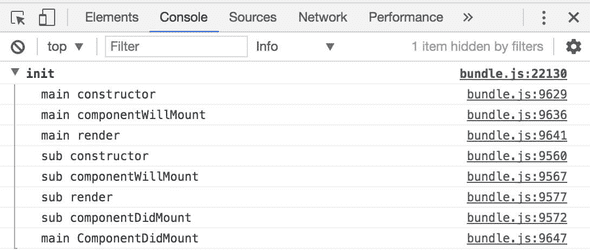react组件生命周期浅谈
June 19, 2017/ Edit on Github ✏️众所周知,react 的组件是有一个个的钩子函数,构建成的生命周期,在用 es6 的 class 与用 createClass 有所不同,其中 createClass 还包括了getDefaultProps与getInitialState。由于 createClass 将在后续版本中移除,建议使用 class 形式。所以,下面讨论的都是 class 形式下的生命周期方式。
初始阶段
- constructor ,构造函数,在初始化实例时首先触发
- componentWillMount,组件将渲染出来之前触发,可以调用 setState,简单的合并 state,不会触发 render 重新渲染
- render ,将组件渲染,不可以调用 setState
- componentDidMount,组件渲染之后触发,可以调用 setState,会重新触发 render
更新阶段
- componentWillReceivePorps,组件获取新的 props 时触发
- shouldComponentUpdate,组件在调用 setState 重新更新 render 之前调用,如果返回 false,则不触发后续的生命周期的方法,不会更新组件的渲染,返回 true,则一定会触发后续的生命周期方法,一定会重新更新组件的渲染,在这个方法里不能调用 setState,如果不小心调用,会造成死循环
- componentWillUpdate,组件在更新阶段,即将更新组件之前触发,不可调用 setState,如果不小心调用,会造成死循环
- Render,组件进行更新,不可调用 setState
- componentDidUpdate,组件更新之后触发,
卸载阶段
- componentWillUnmount,组件即将卸载之前触发,在这里一般做一些清理工作,也不可调用 setState
说完上面这些方法,就需要实际去验证了,我写了一个最基本的组件,且包含了它所有的生命周期的方法,看各个方法执行的情况。代码如下,其中 Test 与 App 大体类似,就不列出来了。
export class App extends Component {
constructor(props) {
super(props)
this.state = {
name: "zy",
}
console.log("main constructor")
}
componentWillMount() {
console.log("main componentWillMount")
}
render() {
console.log("main render")
return <Test name={this.state.name} />
}
componentDidMount() {
console.log("main ComponentDidMount")
}
componentWillReceiveProps() {
console.log("main componentWillReceiveProps")
}
shouldComponentUpdate() {
console.log("main shouldComponentUpdate")
return true
}
componentWillUpdate() {
console.log("main componentWillUpdate")
}
componentDidUpdate() {
console.log("main componentDidUpdate")
}
componentWillUnmount() {
console.log("main componentWillUnmount")
}
}初始化时,查看 Console 控制台的打印情况如下,

再来看看更新阶段的情况,


若有收获,小额鼓励
